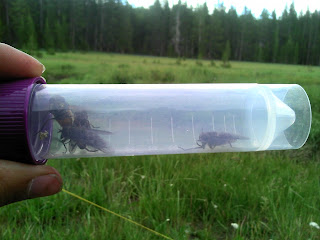Project Description
BACKGROUND
Elaeophora schneideri is a parasitic nematode which infects cervids as well as wild and domestic sheep. Elaeophora schneideri can cause elaeophorosis which includes: dry gangrene of nose and ear tips, antler malformations, blindness, central nervous system damage, filarial dermatitis, ataxia, and death. The presumed low prevalence of elaeophorosis in Wyoming in the late 20th century led researchers to declare it of little to no importance to Wyoming elk or moose. In comparison, the Wyoming State Veterinary Laboratory has attributed E. schneideri to the deaths of several moose and to cases of clear-eyed blindness. Based on surveillance of hunter-harvested, targeted, and road-kill moose for the parasite by the Wyoming Game and Fish Department, prevalence in moose is 42%, the highest ever documented. Many moose herd units have experienced decreased harvest rates in conjunction with declining population trends in Wyoming. While the causes of this decline are not fully understood, disease may be a contributing factor.
Horse flies act as intermediate hosts for E. schneideri, ingesting microfilaria while feeding on infected individuals and re-infecting other ungulates during subsequent feedings. Little is known about the role horse flies play in the host-parasite cycle in Wyoming. With a more pronounced understanding of the role horse flies play in transmission, the more effective researchers will be at determining how E. schneideri is spread among species, the pervasiveness of infections, and the impact on moose populations.
Project Goal
The goal of this project is to determine what factors drive the differences in prevalence of arterial worm in moose. To accomplish this, horse flies from areas with known high and low prevalence will be collected. Horse flies can then be tested to determine which are carrying the parasite and what hosts they prefer to feed on. By comparing relevant horse fly species across Wyoming, we can determine if the differences in prevalence in moose coincide with differences in species composition of horse flies. Determining host preferences of horse flies will elucidate the role of moose in the life cycle of E. schneideri. This information will help wildlife managers understand the conditions that lead to increased prevalence of elaeophorosis.
Objectives
1. Identify species of horse flies found among moose herd units
2. Determine relevant vectors for E. schneideri
3. Determine host preferences of horse flies using PCR
PROJECT MERIT
This research will allow us to describe the interspecific transmission of E. schneideri among host species. Creating an index of horse fly species, their abundance and prevalence, along with host utilization will enable researchers to have a better understanding of the distribution of high and low disease prevalence across Wyoming. Host use data, abundance, and distribution of horse flies are also likely to be broadly applicable to the understanding and management of other zoonotic diseases. Additionally,E. schneideri infections have been documented in other moose populations in the US. Moose declines are a nationwide issue and we expect the information gained to be of benefit to wildlife managers throughout the US. With a more pronounced understanding of the role horse flies play in transmission, the more effective researchers will be at determining how E. schneideri is spread among species, the pervasiveness of infections, and the impact on moose populations.
Tuesday, July 10, 2012
Just returned from the Bighorn Mountains, traps were set up in the Burgess Junction area along Route 14. I had much better success catching horse flies this time thanks to the nice weather. I have also been catching horse flies from horses which has helped to increase my sample sizes. I was lucky enough to see two moose calves during my stay as well as several mule deer fawns.


No comments:
Post a Comment